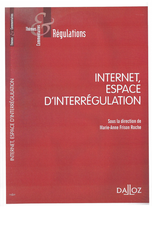Interregulation
ComplianceTech®

Regulation has arisen from the need to take account of the specific nature of the sectors, often accompanied by their liberalization.
But, first of all, goods from different sectors can be substitutable. Thus, both gas and electricity can be heated, as intermodal competition makes the segmentation of regulation of the electricity sector and regulation of the gas sector less relevant to the idea of a single sector of "energy", which nevertheless allows the regulation of water and oil out of its grip. Similarly, a life insurance contract is both an instrument of protection for the future, a product that is therefore covered by insurance Regulation, but also a financial product placed with consumers by banking-insurance companies, objet to the banking regulatory control. This intimacy of regulation with respect to the internal technicality of the object on which it bears can not be erased.
The interregulation that will take place is initially institutional. That is why an alternative opens: either the regulatory authorities are merged, and thus the UK's Financial Services Authority (FSA) has merged financial and banking regulation in 2000, what has not done the French system. Thus, the first branch of the alternative is the institutional fusion, at the risk of constituting kinds of titans, or even reconstituting the State. Either procedures for consultation and joint work are established to create contact points, or even a common doctrine among regulators, as it is between ESMA, EBA and EIOPA in the UE regulatory mechanisms.
The other branch of the alternative is to respect this initial relationship between regulation and the sector and to take note of the links between sectors through the proposed concept of "interregulation". This involves setting up networks between autonomous authorities, but exchanging information, meeting, collaborating on common issues, and so on. This interregulation may initially be horizontal when authorities from several sectors collaborate, for example, ESMA, EBA and EIOPA. It may also be vertical when the authorities of national sectors collaborate with foreign authorities or European or international authorities, as envisaged by the Lamfalussy process in financial matters (extended to the banking and insurance sectors) or the Florence Process in the field of telecommunications or the Madrid Energy Process, where European national regulators meet and work together. This can take more formal institutional forms, such as in telecommunications, with BEREC, or in energy matters with ACER, with and around the European Commission. The comitology technique has generalized this institutional formula.
Interregulation is then notional, a "common law" of regulation developing, common between all sectors. This "common law" (horizontal law) came after the maturity of sectoral regulation laws (vertical laws). It develops in fact because regulated objects are located on the border of several sectors, or even ignore these borders : for example financial derivatives on underlying agricultural or energy. Moreover, "connected objects" generate interregulation in digital space. Thus, even though it is possible that the Internet may give rise to an "interregulation" before giving rise to a specific regulation, the latter can then justify that the first one is dispensed with. That has not happened yet. This regulation of the digital world should be global. It is therefore possible that there remains a mechanism of interregulation.
comments are disabled for this article